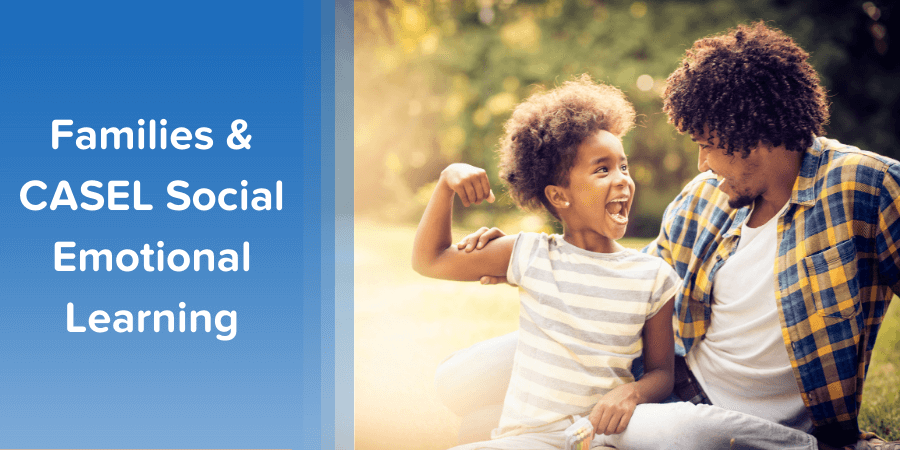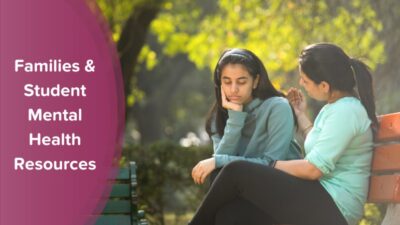by Maren Madalyn, contributing writer
Recently I was texting with a friend who teaches math at our local high school. We were discussing the ongoing concerns surrounding student mental health, social-emotional wellbeing, and academic achievement in the wake of the pandemic.
Like many of us in the education space, her principal and teaching team wanted to better prepare her students for life outside of tests, essays, math pop quizzes, etc. In 2019, and after much research, her school officially adopted the CASEL social emotional learning (SEL) framework as guidance for teaching students these core life skills.
New to the CASEL social emotional learning approach? Read our FAQs at the end of the article for more information.
Barely a year later, the pandemic threw the school’s SEL plans out the window as their community struggled to adapt to the rapidly changing situations. Now, several years later, her principal was reviving the original gameplan, asking all teachers to incorporate the elements of the framework into their academic instruction. My friend was feeling the pressure.
I recall her texting me this at one point in our conversation: How on earth are teachers supposed to teach SEL competencies necessary for each grade level AND boost math scores AND manage everything else on our plates? We can’t do it alone.
And she’s right. To build social-emotional competence in students, teachers need the entire school community – and that includes families. It is a positive step forward that her school recognizes the value of social emotional learning and seeks to use it to improve school climate and their COVID recovery efforts. But there is even more opportunity beyond the classroom to build these skills.

School leaders can leverage their partnerships with families to implement SEL models within their communities to improve student learning outcomes.

The power of life skills on student outcomes
Why do life skills and social emotional learning matter so much in the first place? Because these capabilities are absolutely essential for a student to be successful – not only in the classroom environment, but in the world beyond.
A wealth of research indicates there are tremendous benefits for students who participate in programs that develop life skills. Just to name a few, these positive outcomes include improved attitudes towards themselves and others, gains in test scores, and fewer behavioral problems.

Further, these benefits persist in students’ lives well after they finish school, too. According to one long-term study, kindergarteners with higher social emotional competencies were more likely to graduate high school and college, as well as secure stable employment in the workforce afterward.
Teaching such fundamental skills has an intimate relationship with educational equity, too. To create a more equitable school environment, one needs abilities such as perspective taking, active listening, and collaborative problem solving – core skills often taught in social emotional learning programs. These skills help students and educators alike to build positive relationships within communities made up of unique backgrounds and cultures. SEL also encourages school communities to celebrate and value diversity as a strength – and to recognize what resources each individual student needs to optimize learning and growth.
We at ParentPowered know how critical social emotional learning is to student success and learning equity. Our ParentPowered curricula draws upon a broad set of research, expertise, and best practices to inform our content shared with families. Each of our SEL activities concentrate on building one or more evidence-based skills and competencies linked to positive student outcomes. Ultimately, by teaching students critical social emotional learning skills, educators and families set their students on the course to becoming healthy, productive adults in the world.
Let’s look at one of the more commonly recognized frameworks for social-emotional learning, and the one my friend is helping implement in her high school. Together, we will unpack how those organizations using the CASEL social emotional learning approach may use it to guide school teams and families in building core social-emotional skills in students.
A snapshot of the CASEL social emotional learning framework
One of the most widely adopted SEL frameworks, the CASEL “Big Five” Framework provides educators, schools, and entire communities with guidance on how to implement life skills instruction to students of all ages. According to CASEL, this model is designed to be “a systemic approach that emphasizes the importance of establishing equitable learning environments and coordinating practices.” Their resources cover social emotional programs across multiple key settings for learning, including classrooms, schools, the home environment, and broader communities. The goal of this holistic approach is “to enhance all students’ social, emotional, and academic learning.”
Originally created in the 1990s, the framework was updated in 2020 to reflect its current form highlighting five core competencies of SEL – the essential elements of life skills in students. These five social-emotional competencies are:
- Self-awareness
- Self-management
- Social awareness
- Relationships skills
- Responsible decision making

Here’s the thing about the CASEL social emotional learning approach – or really, any SEL strategy that district or school leaders use to build students’ life skills. It’s important to consider the role of families in cultivating social emotional skills in students and how to loop parents into the framework you’ve chosen to drive your organization’s SEL goals.
By understanding the connections between family engagement and SEL, schools can then maximally leverage such frameworks to improve student outcomes.
How families benefit from supporting social emotional learning
Families are the first teachers in a student’s life, especially when it comes to developing basic life skills – including those highlighted in the CASEL social emotional learning model. Educators that engage families in SEL strategies offer students the best chance to grow these skills for long-term success. And students aren’t the only ones that benefit.
Let’s think about a core competency like relationship skills. Positive relationships require practicing skills like communication, perspective-taking, and active listening. By modeling these skills with others even when they may disagree with them, parents show students how to create their own healthy relationships with different people.

Taking it a step further, families can use these skills to improve their own relationships with one another. In fact, open, two-way communication is essential to build trust in any relationship, whether it’s between a parent and a child, or a family and their school.
Proficiency in self-management, another core SEL competency, also relies on families engaged in their students’ social emotional learning. Stress and hard emotions are a part of life, and learning how to navigate them is essential for anyone’s wellbeing. When adults practice self care, they in turn can show up more effectively for their families, their friends, their kids, and their communities.
Practicing stress management not only benefits families, but it also encourages students to learn how to recognize and care for their own emotional needs, both now and in the future. Students that utilize strategies to manage stress and hard emotions are better prepared for both the classroom experience and life beyond school – tools especially crucial to student mental health after the peak of the COVID-19 pandemic.

By inviting families to partner in their social emotional learning strategies, educators create the best possible circumstances for students to grow and thrive – and help families thrive, too.

5 ways families can contribute to student social emotional learning
So, in collaboration with families, how can educators encourage social emotional learning beyond the classroom? Fortunately, a parent doesn’t need additional training or certification to take advantage of what their SEL framework has to offer – whether it is CASEL, the Wallace Foundation Framework, or another!
ParentPowered has created numerous low-effort, high-impact activities that cultivate life skills in students – designed specifically with families in mind. Through ParentPowered Core and Trauma-Informed, parents and caregivers receive weekly tips and activities via text to support children’s development. Our SEL content highlights ways families can develop students’ ability to problem solve; their capacity to meet goals; build supportive relationships, resilience, and a positive sense of self; navigate emotions; and be a caring part of a community.
Our team curated their favorite family activities that can support educators using the “Big Five” competencies to inform their schools’ social emotional learning approach. Share these with your families or team for inspiration!
Cultivating social awareness
Our world is filled with unique people that have diverse experiences, cultural identities, and perspectives. According to CASEL, strong social awareness greatly helps students navigate the multitude of different people around them and develop cultural competency. These skills also support students to recognize the broader contexts that may impact cultural and behavioral norms.
For instance, the ability to take another person’s perspective – to empathize with them – enables students to build better connections with people, both in their daily school life and beyond. Better connections means students can more successfully resolve conflict in a constructive manner, even in varying cultural contexts. And practicing conflict resolution skills in school and at home means that students have the tools needed to face challenges later on as adults.

Families are well positioned to cultivate social awareness in students. Here’s a great activity for families of elementary school kids to do at home that emphasizes the importance of lending a hand in their community:
- FACT: Helping others is key to any community. When you talk with your child about helping others, you show them that you value this important skill.
- TIP: At dinner, ask, “What’s one thing you did to help someone today?” Let everyone answer. Then ask, “What’s one thing someone did to help you?”
- GROWTH: Keep talking about helping. Now mention one way that your child has helped you lately: “It was really helpful when you unloaded the groceries.”
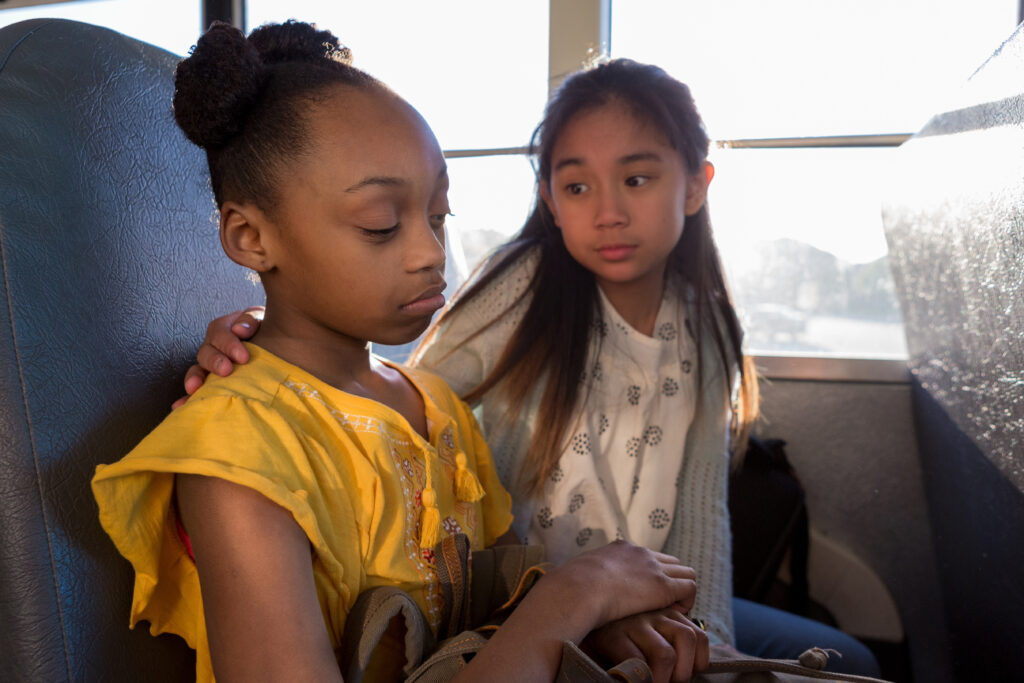
Practicing responsible decision making
Adults are expected to make constructive choices on a regular basis, both personally and in social contexts. According to CASEL, responsible decision making includes learning how to analyze data and facts to make reasoned judgments, anticipate the consequences of one’s decisions, and even reflect on one’s own crucial role within their family, school, or community.
Problem-solving skills closely connect with responsible decision-making in students. Both families and school staff can implement this activity designed for older students to cultivate their problem-solving skills:
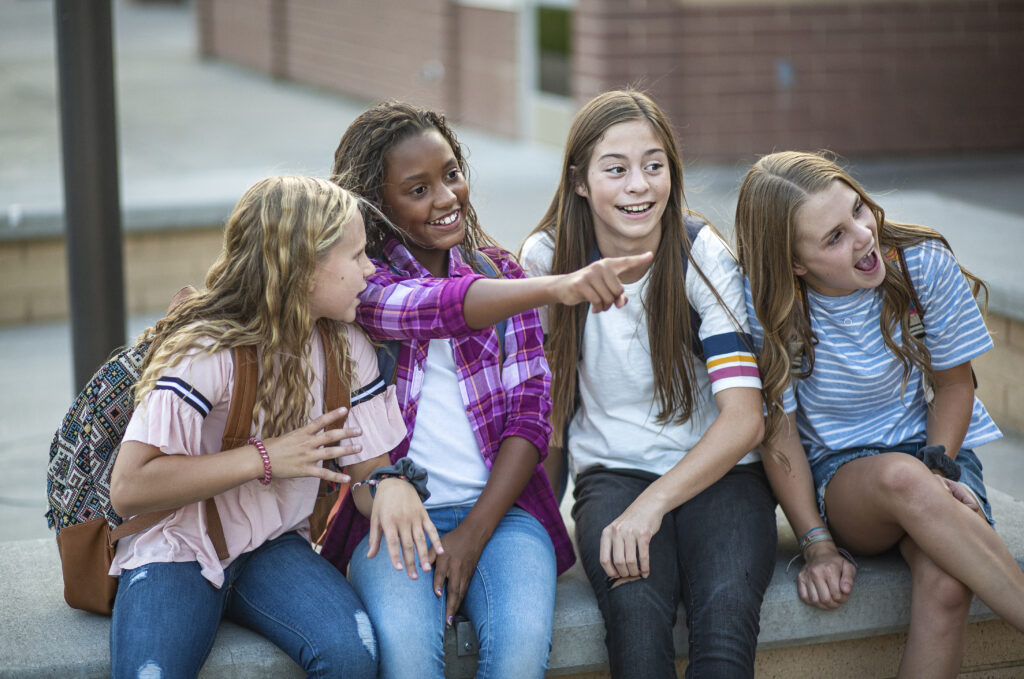
- FACT: Middle schoolers need to solve some problems on their own. Help them think through solutions by asking questions. You’re building their independence.
- TIP: Next time your child’s having a problem (in school, with friends), ask questions. “What might help the situation? What else?” Try for lots of solutions.
- GROWTH: Keep supporting your child in solving problems on their own. Talk through the different solutions. Ask: “What might happen if you tried that solution?”
Developing relationship skills
Having healthy relationships is a necessary part of living a fulfilled life. CASEL highlights a handful of core social skills that contribute to building and maintaining positive relationships. These include communication skills, navigating social situations with cultural competence, and recognizing and responding to emotions that others may be experiencing.
Whether it’s encouraging active civic engagement or simply practicing active listening, families play a critical role in fostering relationship skills with students. In fact, active listening is not only powerful for students – it is a game-changing communication skill for adults, too!
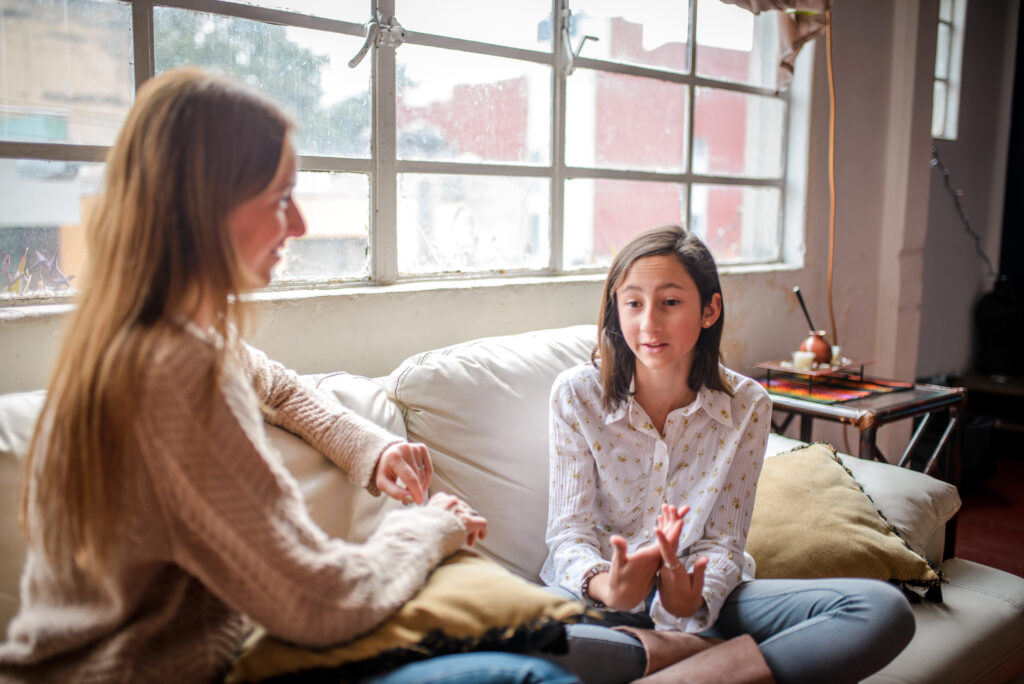
This activity is an excellent way for parents of younger kids to both practice and model positive listening skills that lead to stronger relationships with others:
- FACT: Good friends are good listeners. When you help your child build good listening skills, you help them build key skills for making and keeping friends.
- TIP: Model good listening at the end of the day. Look your child in the eye and give them your full attention as you ask, “What’s a fun thing you did today?”
- GROWTH: Keep listening. Now try a listening game. Name 3 things that you did today. Then ask your child, “So what 3 things did I do today?” See if your child can repeat them all!
Encourage self-awareness
When we think of ‘self-awareness’, we might first think of emotional intelligence or one’s sense of self. But CASEL emphasizes that cultivating self-awareness extends to one’s social identities, hobbies, interests, and learning mindset, too. In fact, research has shown that instilling a growth mindset in students builds resilience in the face of challenges and an appreciation for others’ successes, both of which contribute to creating supportive classroom environments. Strong self-awareness is also crucial to building self-confidence, a key trait that will support students at every stage of life.
Here’s a wonderful activity for kindergarten families to use at home that encourages healthy self-confidence and builds a sense of self:
- FACT: The more kids know about themselves, the more confident they’ll be. Saying good things about your child and what they like builds this confidence.
- TIP: At bedtime, name 3 things your child does really well, “You are great at making people laugh, you are very kind….” Give a kiss for each thing.
- GROWTH: Keep talking to build self-awareness. In the morning, ask your child, “What’s one thing you want everyone in the world to know about you?”
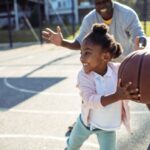
Instilling self-management
As students get older, they are expected to independently take care of their school work, allocate their time appropriately, tend to their own needs, and manage age-appropriate tasks alone. These executive functioning skills are just a few examples of the competencies for students’ self-management.
CASEL describes self-management as skills that help regulate one’s self – emotions, personal behavior, goals, and even one’s initiative to take action. Families can help students build these skills outside of the school day, knowing that they will benefit their children’s academic development during school time, too.

Here’s an easy way for your families to support their children to practice emotional self-management when they feel stressed. It’s perfect for middle school students especially, as they are experiencing tremendous shifts in their independence:
- FACT: Moments of stress and frustration are a normal part of life. Building coping strategies, like taking deep breaths, helps kids work through these moments.
- TIP: If your child starts to give up on a task, try a breath break. Together, breathe in for 3 and then out for 5. Ask, “Do you feel ready to try again?”
- GROWTH: Breath breaks work for you too! When stress is bubbling up, pause to breathe. As you do, focus on breathing out. It’s what calms the body and mind.


Social emotional learning benefits students at home and beyond
There can be no doubt that students need to learn core life skills to thrive as adults in our world. As my friend wisely shared, educators can’t take on this challenge alone. Fostering collaborative relationships with families not only supports educators to cultivate thriving schools – such partnership with families is an incredible catalyst for academic learning as well as students’ social and emotional development.
By building authentic partnerships with their families, and bringing them into whatever SEL efforts schools undertake, school leaders tap into the immense potential that these crucial stakeholders offer and help students thrive. And when students thrive, the entire school community thrives!

FAQs: The CASEL Social Emotional Learning Approach
Want to learn more about the CASEL approach to social and emotional learning? You can start with these frequently asked questions. For more information, visit their website.
1. What is the Collaborative for Academic, Social, and Emotional Learning (CASEL)?
CASEL is one of several organizations championing life skill-building in students. In fact, they first coined the phrase “social emotional learning” in 1994! They provide schools and teachers with evidence-based resources and strategies to help students develop key social emotional skills in the classroom. Their work centers on the CASEL Framework, a model that highlights five core competencies making up the essentials of social emotional learning.
2. What is CASEL’s definition of ‘life skills’?
CASEL defines these skills as “an integral part of education and human development. SEL is the process through which all young people and adults acquire and apply the knowledge, skills, and attitudes to develop healthy identities, manage emotions and achieve personal and collective goals, feel and show empathy for others, establish and maintain supportive relationships, and make responsible and caring decisions.”

3. What are the “Big Five” competencies in CASEL’s framework?
Take a look at each of the “Big Five” competencies and their definitions below:
- Self-awareness refers to “the ability to accurately recognize one’s own emotions, thoughts, and values and how they influence behavior.” In other words, self-awareness helps people make informed decisions in their lives.
- Self-Management focuses on healthy ways to manage emotions and behaviors in order to achieve one’s goals. As CASEL points out, people with strong self-management skills are better able to handle stress, manage time effectively, set priorities, and cope with challenges.
- Social Awareness means that one recognizes the perspectives and diverse experiences of other people. This competency involves understanding and appreciating what makes others unique, recognizing and responding to the needs of others, and developing empathy.
- Relationship Skills refers to one’s ability “to establish and maintain healthy and supportive relationships” with others. It also encompasses the capacity to navigate settings and groups with diverse people in a positive way.
- Responsible Decision Making emphasizes making ethical, thoughtful, and caring decisions, with awareness of the consequences it brings. This competency’s skills can include identifying risks and taking responsibility for one’s decisions or actions.
About the author
Maren Madalyn has worked at the intersection of K12 education and technology for over a decade, serving in roles ranging from counseling to customer success to product management. She blends this expertise with fluid writing and strategic problem-solving to help education organizations create thoughtful long-form content that empowers educators.

